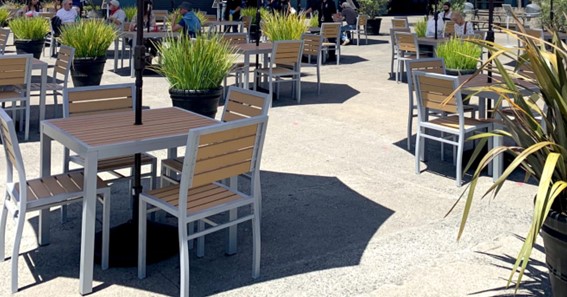When starting a new business, there are many things to consider, including location, target market, products and services, interior and exterior design, and furnishings. Although buying a few pieces of furniture from your local furniture retail store may be tempting, there are costs to consider. But doing this is not recommended.
Furniture has entirely different qualities depending on whether it is used at home or in a commercial setting. As a result, if you’re beginning a business, you should consider purchasing furniture made for commercial or contract environments for your café, restaurant, or workplace.
WHAT IS COMMERCIAL FURNITURE
Commercial-grade furniture, sometimes contract-grade furniture, is used in commercial settings or for business-related purposes. This table is made to a higher standard than those sold in your local retail stores.
Commercial outdoor furniture is necessary for high-traffic areas, including parks, eateries, hotels, hospitals, and airports. It has them all, from couches to bar stools to chairs and tables. Since they are made to withstand more rigorous wear and tear, these pieces of furniture are not easily destroyed or damaged.
Unlike domestic or residential grade furniture, which is only meant for mild daily use, the commercial table is constructed of more robust materials for heavy usage. Additionally, it is resistant to the elements and appropriate for indoor and outdoor use.
HOW COMMERCIAL FURNITURE GETS TESTED
To guarantee that the commercial-grade table is of the highest caliber, many tests are carried out on batch representatives of manufactured furniture. After completing these tests, they are awarded certifications recognized as global standards.
- A WEIGHING PROCEDURE
Weight testing is done to determine the most weight that a particular piece of furniture can hold. People of diverse body types use seats. Therefore, it is crucial for chairs.
Home-grade furniture typically has a weight limitation of 150 kilograms, whereas commercial-grade tables have a weight restriction of 300 kilograms. This suggests that even when a significant, high load is imposed on a commercial-grade chair, it won’t break or lose its structural or mechanical integrity.
Click here – Three Steps to Rapidly Acquire High-Quality Office Space
- A LOAD TEST
Various weights or loads are connected to the back or legs to see if there will be a structural breakdown or rapid change in the chair’s integrity. This is done to check whether the chair is still functional and helpful even when put under stress or weight.
- DROP TESTING
Weights are configured to drop onto the middle of the chair quickly. The drop test succeeded if the chair sustains no damage or retains its structural integrity.
This test simulates situations in which a big object, box, or another piece of furniture accidentally falls over the chair. It also serves a functional purpose since when someone stands up from a chair, and more weight must be supported than when they are only sitting.
- STRENGTH TEST
A man’s weight is put on the chair while the front or rear legs are subjected to force or load to assess the chair’s ability to move forward and backward. Testing for stability ensures that the ideal balance is maintained even on uneven ground.
- UV TESTING
It is put through UV testing to determine whether a piece of furniture is suitable for outdoor usage. For instance, to ensure that harsh, direct sunlight won’t deteriorate or damage the quality of the table, park benches, and chairs for outdoor seating are subjected to UV testing. It also suggests it may endure lengthy sun exposure without damaging its structure or operating ability.
- ROUGHNESS TEST
Commercial-grade furniture is made to endure damage and heavy use as a result. The materials are more durable, long-lasting, and sturdy than conventional household furniture. Furthermore, even under great stress or pressure, the furniture’s quality is unaltered.
